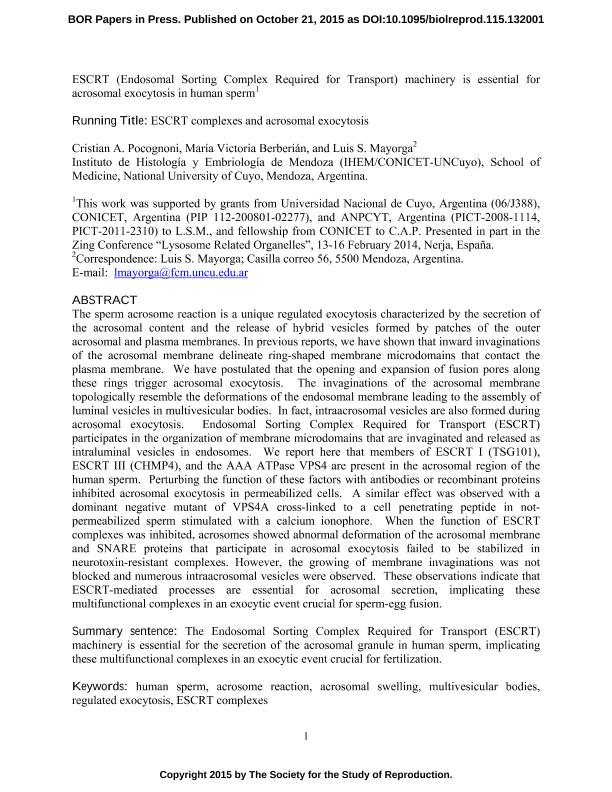Mostrar el registro sencillo del ítem
dc.contributor.author
Pocognoni, Cristián Adrián

dc.contributor.author
Berberian, Victoria

dc.contributor.author
Mayorga, Luis Segundo

dc.date.available
2018-09-12T19:06:13Z
dc.date.issued
2015-11
dc.identifier.citation
Pocognoni, Cristián Adrián; Berberian, Victoria; Mayorga, Luis Segundo; ESCRT (endosomal sorting complex required for transport) machinery is essential for acrosomal exocytosis in human sperm; Society for the Study of Reproduction; Biology of Reproduction; 93; 5; 11-2015; 1-23
dc.identifier.issn
0006-3363
dc.identifier.uri
http://hdl.handle.net/11336/59394
dc.description.abstract
The sperm acrosome reaction is a unique, regulated exocytosis characterized by the secretion of the acrosomal content and the release of hybrid vesicles formed by patches of the outer acrosomal and plasma membranes. In previous reports, we have shown that inward invaginations of the acrosomal membrane delineate ring-shaped membrane microdomains that contact the plasma membrane. We have postulated that the opening and expansion of fusion pores along these rings trigger acrosomal exocytosis. The invaginations of the acrosomal membrane topologically resemble the deformations of the endosomal membrane leading to the assembly of luminal vesicles in multivesicular bodies. In fact, intra-acrosomal vesicles are also formed during acrosomal exocytosis. Endosomal sorting complex required for transport (ESCRT) participates in the organization of membrane microdomains that are invaginated and released as intraluminal vesicles in endosomes. We report here that members of ESCRT I (TSG101), ESCRT III (CHMP4), and the AAA ATPase VPS4 are present in the acrosomal region of the human sperm. Perturbing the function of these factors with antibodies or recombinant proteins inhibited acrosomal exocytosis in permeabilized cells. A similar effect was observed with a dominant-negative mutant of VPS4A cross-linked to a cell-penetrating peptide in nonpermeabilized sperm stimulated with a calcium ionophore. When the function of ESCRTs was inhibited, acrosomes showed abnormal deformation of the acrosomal membrane, and SNARE proteins that participate in acrosomal exocytosis failed to be stabilized in neurotoxin-resistant complexes. However, the growing of membrane invaginations was not blocked, and numerous intra-acrosomal vesicles were observed. These observations indicate that ESCRT-mediated processes are essential for acrosomal secretion, implicating these multifunctional complexes in an exocytic event crucial for sperm-egg fusion.
dc.format
application/pdf
dc.language.iso
eng
dc.publisher
Society for the Study of Reproduction

dc.rights
info:eu-repo/semantics/openAccess
dc.rights.uri
https://creativecommons.org/licenses/by-nc-sa/2.5/ar/
dc.subject
Acrosomal Swelling
dc.subject
Acrosome Reaction
dc.subject
Escrts
dc.subject
Human Sperm
dc.subject
Multivesicular Bodies
dc.subject
Regulated Exocytosis
dc.subject.classification
Otras Ciencias Biológicas

dc.subject.classification
Ciencias Biológicas

dc.subject.classification
CIENCIAS NATURALES Y EXACTAS

dc.title
ESCRT (endosomal sorting complex required for transport) machinery is essential for acrosomal exocytosis in human sperm
dc.type
info:eu-repo/semantics/article
dc.type
info:ar-repo/semantics/artículo
dc.type
info:eu-repo/semantics/publishedVersion
dc.date.updated
2018-09-12T13:58:17Z
dc.journal.volume
93
dc.journal.number
5
dc.journal.pagination
1-23
dc.journal.pais
Estados Unidos

dc.journal.ciudad
Madison
dc.description.fil
Fil: Pocognoni, Cristián Adrián. Consejo Nacional de Investigaciones Científicas y Técnicas. Centro Científico Tecnológico Conicet - Mendoza. Instituto de Histología y Embriología de Mendoza Dr. Mario H. Burgos. Universidad Nacional de Cuyo. Facultad de Ciencias Médicas. Instituto de Histología y Embriología de Mendoza Dr. Mario H. Burgos; Argentina
dc.description.fil
Fil: Berberian, Victoria. Consejo Nacional de Investigaciones Científicas y Técnicas. Centro Científico Tecnológico Conicet - Mendoza. Instituto de Histología y Embriología de Mendoza Dr. Mario H. Burgos. Universidad Nacional de Cuyo. Facultad de Ciencias Médicas. Instituto de Histología y Embriología de Mendoza Dr. Mario H. Burgos; Argentina
dc.description.fil
Fil: Mayorga, Luis Segundo. Consejo Nacional de Investigaciones Científicas y Técnicas. Centro Científico Tecnológico Conicet - Mendoza. Instituto de Histología y Embriología de Mendoza Dr. Mario H. Burgos. Universidad Nacional de Cuyo. Facultad de Ciencias Médicas. Instituto de Histología y Embriología de Mendoza Dr. Mario H. Burgos; Argentina
dc.journal.title
Biology of Reproduction

dc.relation.alternativeid
info:eu-repo/semantics/altIdentifier/doi/https://dx.doi.org/10.1095/biolreprod.115.132001
dc.relation.alternativeid
info:eu-repo/semantics/altIdentifier/url/https://academic.oup.com/biolreprod/article/93/5/124,%201-12/2434368
Archivos asociados
